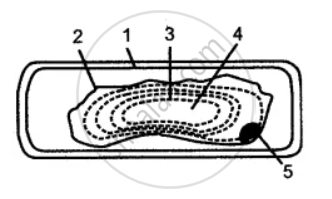Advertisements
Advertisements
Question
The diagram below represents a process in plants. The setup was placed in bright sunlight. Answer the following questions:

a) Name the physiological process depicted in the diagram.
Why was oil added to the water?
b) When placed in bright sunlight for four hours, what do you observe with regard to the initial and final weight of the plant? Give a suitable reason for your answer
c) What happens to the level of water when this setup is placed in:
- Humid conditions?
- Windy conditions?
d) Mention any three adaptations found in plants to overcome the process mentioned in (i).
e) Explain the term ‘Guttation’.
Solution
a)
- Transpiration
- Oil was added to the water to prevent its evaporative loss.
b) Upon exposure to bright sunlight for four hours; the final weight will be lesser than the initial weight; because some water will be lost from the aerial parts of the plant by transpiration.
c)
- No change in the level of water
- The level of water drops.
d) The three adaptations found in plants to overcome transpiration are:
- Sunken stomata: The stomata may be sunken or covered by hairs (eg. Nerium)
- Narrow leaves: The leaves may become narrower to reduce surface area.
- Fewer stomata: The number of stomata may be reduced.
e) The leaves of certain plants exhibit droplets of water along their margins in the morning. This particularly happens in plants growing in warm humid conditions. A humid environment hampers transpiration while the roots continue to absorb water from the soil. This builds up a high hydrostatic pressure within the plant and “forces out” the excess water directly from the tips of veins in the leaf by a process called guttation.
APPEARS IN
RELATED QUESTIONS
Explain Turgor pressure
Differentiate between the following:
Turgor pressure and wall pressure
Differentiate between the following:
Turgidity and Flaccidity
Give reasons for the following:
If you sprinkle some common salt on grass growing on a lawn, it is killed at that spot.
Give reason for the following:
It is better to transplant seedlings in a flower-bed in the evening and not in the morning.
The below diagram represents a plant cell after being placed in a strong sugar solution. Guidelines 1 to 5 indicate the following:
1. Cell wall
2. Plasma membrane.
3. Protoplasm
4. Large vacuole
5. Nucleus
Study the diagram and answer the questions that follow :
(i) What is the state of the cell shown in the diagram?
(ii) Name the structure which acts as a selectively permeable membrane.
(iii) If the cell had been placed in distilled water instead of a strong sugar solution which features: would not have been present?
(iv) If the cell in the diagram possessed chloroplasts where would these be present?
(v) Name any one feature of this plant cell which is not present in animal cells.
Name the following:
The process by which wilting or drooping of leaves occurs.
Fill in the Blank
The condition opposite to turgid is ___________.
Fill in the Blank
Wilting and drooping of leaves is due to loss of ________.
When the cells of a plant are fully distended, the condition is called ______.
